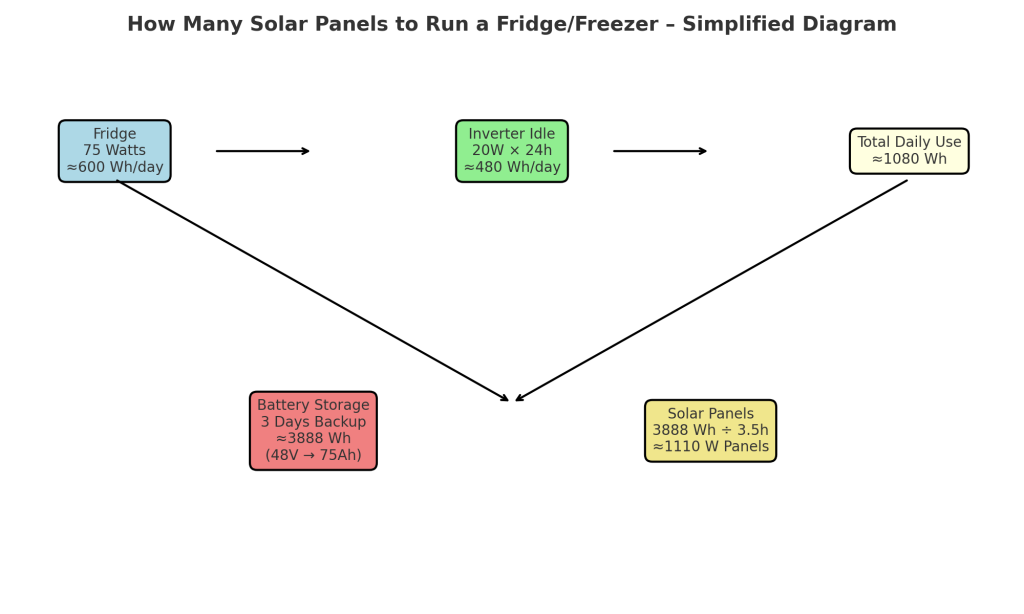Running your fridge or freezer on solar power is not only possible but also more efficient than many people think. In this guide, we’ll break down how much power a fridge uses, the role of the inverter, the battery size required, and the exact number of solar panels you need to keep your fridge running 24/7.
Why Consider Running a Fridge on Solar Power?
Refrigerators are one of the most essential home appliances. But they also run day and night, making them a big contributor to your electricity bill. By shifting your fridge to solar power, you can:
-
Reduce energy costs
-
Ensure backup power during outages
-
Move closer to an off-grid lifestyle
Step 1: Measuring the Fridge Power Consumption
A typical refrigerator doesn’t run continuously. Although it may be rated at 75 watts, the compressor only works for about 30% of the time.
👉 Example calculation:
-
8 hours multiplied by 75 watts equals 600 watt-hours per day.
Your actual usage may vary depending on:
-
Room temperature
-
How often you open the fridge
-
Fridge size and efficiency
For accuracy, it’s best to use an energy meter and measure your fridge’s consumption for one full week.
Step 2: Don’t Forget Inverter Idle Consumption
Most people overlook this part. Even when your inverter is not actively powering a load, it consumes energy.
👉 Example calculation:
-
20 watts multiplied by 24 hours equals 480 watt hours per day.
When combined with the fridge’s daily usage:
-
600 watt hours + 480 watt hours = 1,080 watt hours daily total.
Step 3: Calculating Battery Size

Since the sun isn’t always shining, you’ll need a battery backup for cloudy days. A safe estimate is 3 days of autonomy.
With lithium batteries, you only use about 80% of the total capacity (10%–90% state of charge). So we multiply by 1.2.
👉 Example calculation:
-
1,080 watt hours × 1.2 × 3 days = 3,888 watt hours total storage required.
That equals:
-
300 Ah at 12 volts
-
150 Ah at 24 volts
-
75 Ah at 48 volts
💡 Pro tip: A 48-volt system is often cheaper in the long run, since it allows for thinner wires and a more efficient charge controller.
Step 4: How Many Solar Panels Are Needed?
Now comes the big question — the solar panels. To recharge the battery in one day, you must base the calculation on your location’s worst month of sunlight.
For example, in Houston, Texas, the winter average is only 3.5 sun hours per day.
👉 Example calculation:
-
3,888 watt hours ÷ 3.5 hours = 1,110 watts of solar panels required.
This ensures your fridge runs smoothly even in the darkest month of the year.
Key Takeaways
-
Fridge daily use ≈ 600 watt hours
-
Inverter idle loss ≈ 480 watt-hours
-
Battery needed ≈ 3,888 watt hours total (for 3 days autonomy)
-
Solar panels ≈ 1,110 watts (based on 3.5 sun hours)
With these numbers, you can adjust calculations for your own fridge and location.
Final Thoughts
Running a refrigerator or freezer on solar power is absolutely practical when sized correctly. By factoring in fridge consumption, inverter losses, proper battery storage, and realistic solar hours, you can design a system that keeps your fridge running all year round.
⚡ Recommended Batteries & Solar Gear:
Thinking of going solar? Start small with your fridge, and you’ll see how reliable and cost-saving solar energy can really be.
Frequently Asked Questions (FAQ)
1. How many solar panels do I need to run a refrigerator?
It depends on your fridge’s daily power consumption and your location’s sunlight hours. On average, a medium-sized fridge needs about 1,100 watts of solar panels if you want it to run 24/7 with 3 days of backup.
2. Can I run a fridge directly on solar panels without batteries?
Technically yes, but it’s not recommended. A fridge needs to run day and night, and solar panels only produce electricity during sunlight hours. That’s why a battery bank is essential for a reliable setup.
3. How big of a battery do I need for a fridge?
For 3 days of backup with lithium batteries, you’ll need about 3,888 watt-hours of storage. This equals:
-
300 Ah at 12 volts
-
150 Ah at 24 volts
-
75 Ah at 48 volts
4. Do solar-powered fridges exist?
Yes, there are special DC solar fridges designed to work directly with solar panels. However, most people use regular AC fridges with an inverter and battery system.
5. How much does it cost to run a fridge on solar panels?
Costs vary depending on the size of the fridge and local solar panel prices. A complete system (panels, batteries, inverter) can range from a few hundred dollars for small setups to several thousand for larger systems.
6. Is running a fridge on solar power worth it?
Absolutely. Once installed, solar panels generate free electricity, reducing your bills and giving you energy security during power outages. Over time, the investment pays for itself.
Leave a Reply